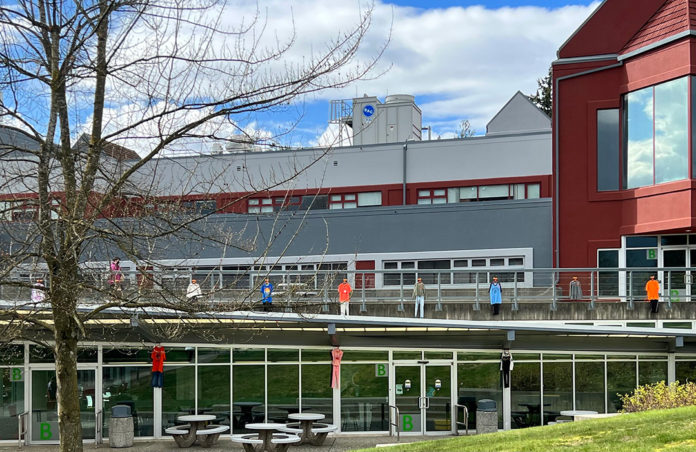In April, the HIST 396O class placed displays of children’s clothing, with small orange ribbons pinned to them, all over the Abbotsford campus. This was a project done in partnership with the Indigineous Affairs office. The displays were placed without announcement or explanation. This was an intentional choice made with the goal of having any students, staff, or visitors of the campus see the displays and make their own connections and understandings.
The children’s clothing displays were not placed because of the finding of unmarked graves from Indian Residential schools. According to Shirley Hardman, Senior Advisor of the Indigneous Affairs office, the displays were simply a way for the students of the HIST 396O class to reflect and to further the journey of the UFV community in reconciliation. The installations are meant to spark discussion and reflection for other individuals who happen upon the project.
Each display had a small orange ribbon pinned to it as the only clue to the message behind the displays. Orange ribbons have held different meanings over the years, both internationally and in Canada. Most recently the major use and symbolism of orange ribbons and t-shirts in Canada was to spread awareness and acknowledgement of the thousands of unmarked graves from the Indian Residential Schools. The choice to use orange ribbons stems from the annual Orange Shirt Day that takes place on Sept. 30.
Hardman said, “it seems important to me that individuals on campus readily recognize an installation of this importance. I also believe that if we are unable to recognize the purpose or representation…then maybe we are personally just not ready for the message. My suggestion then is that reconciliation is hard work.”
Reconciliation is difficult and an important part of the story of Canada. In 2007, the Truth and Reconciliation Commission (TRC) began work on first listening to the many stories of survivors and then spreading awareness. In 2015, the TRC put out a final report more commonly known as the “Calls to Action.” The report included a total of 94 calls to action.
“I believe the openness of people on campus to learn about and talk about and take action towards reconciliation makes us rich as a community,” said Hardman.
The installments of children’s clothing on campus is also a reminder that discussion can take place beyond Sept. 30.“The sentiment of not just on Orange Shirt Day is my primary impetus for wanting a winter semester install,” said Hardman. Having put the displays up in the latter end of the winter semester has allowed for all visitors on the Abbotsford campus to spark dialogue in relation to reconciliation.
Emmaline is working on her BA and ambitions to become an English teacher. They always say, those who cannot do, teach. She spends her free time buying, reading, and hoarding books with the hope that one day she will have no furniture and instead only have piles of books.



